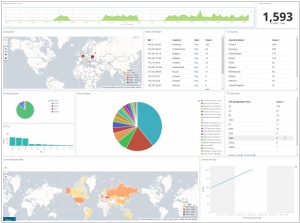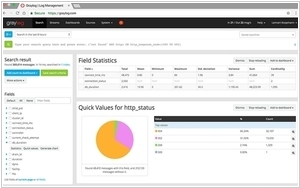ELK vs Graylog
July 31, 2023 | Author: Michael Stromann
13

ELK is the acronym for three open source projects: Elasticsearch, Logstash, and Kibana. Elasticsearch is a search and analytics engine. Logstash is a server‑side data processing pipeline that ingests data from multiple sources simultaneously, transforms it, and then sends it to a "stash" like Elasticsearch. Kibana lets users visualize data with charts and graphs in Elasticsearch.
See also:
Top 10 SIEM software
Top 10 SIEM software
ELK (Elasticsearch, Logstash, and Kibana) and Graylog are both popular open-source log management solutions, but they have some key differences in their architecture and features. ELK stack consists of three main components: Elasticsearch for log storage and indexing, Logstash for log collection and processing, and Kibana for log visualization. On the other hand, Graylog is an all-in-one solution that combines log collection, storage, and analysis with a built-in web interface for visualization. This makes Graylog easier to set up and manage for users who prefer a unified platform, while ELK provides more flexibility for customizing each component to suit specific requirements.
Another significant difference is their approach to data processing. ELK stack relies on Logstash as its primary log ingestion tool, which allows users to apply filters and transformations to the data during collection. Graylog, on the other hand, uses its own pipeline processing system for data enrichment and manipulation, offering a more intuitive and streamlined way to process logs. This difference can be crucial for organizations with complex log processing needs, as Graylog's pipeline processing simplifies the data flow and reduces the need for additional tools.
Lastly, when it comes to scalability, both ELK and Graylog have different strategies. ELK stack, with its separate components, can be more challenging to scale and manage in distributed environments, requiring careful planning and resource allocation. Graylog, with its integrated architecture, can be easier to scale horizontally by adding additional nodes to the cluster. This makes Graylog a more straightforward choice for organizations looking for a scalable log management solution without the added complexity of managing multiple components separately. In summary, the choice between ELK and Graylog depends on the specific requirements of an organization, with ELK offering more customization options and Graylog providing a simpler, all-in-one solution with easier scalability.
See also: Top 10 SIEM software
Another significant difference is their approach to data processing. ELK stack relies on Logstash as its primary log ingestion tool, which allows users to apply filters and transformations to the data during collection. Graylog, on the other hand, uses its own pipeline processing system for data enrichment and manipulation, offering a more intuitive and streamlined way to process logs. This difference can be crucial for organizations with complex log processing needs, as Graylog's pipeline processing simplifies the data flow and reduces the need for additional tools.
Lastly, when it comes to scalability, both ELK and Graylog have different strategies. ELK stack, with its separate components, can be more challenging to scale and manage in distributed environments, requiring careful planning and resource allocation. Graylog, with its integrated architecture, can be easier to scale horizontally by adding additional nodes to the cluster. This makes Graylog a more straightforward choice for organizations looking for a scalable log management solution without the added complexity of managing multiple components separately. In summary, the choice between ELK and Graylog depends on the specific requirements of an organization, with ELK offering more customization options and Graylog providing a simpler, all-in-one solution with easier scalability.
See also: Top 10 SIEM software




